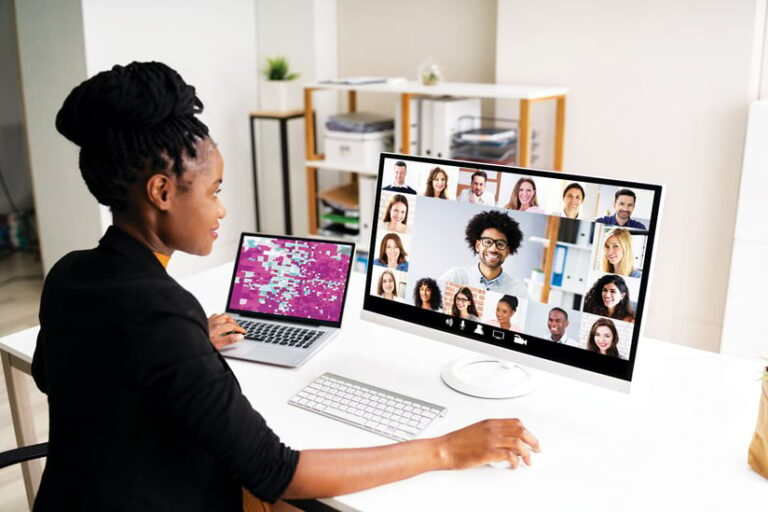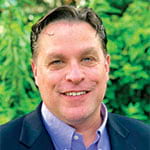Last year, I called the COVID-19 pandemic “the crisis of our lifetime”—one that trained “a merciless lens on the social and racial fissures that already made life difficult for so many people.” (See “Pulling Together When a Pandemic Pulls Our Lives Apart,” from the winter 2021 issue of ArcNews.) This is even truer today, as the pandemic’s impact aggravates newer, equally urgent crises around the world. These stressful events reinforce how vital it is for people to connect, especially when we’re not in the same room or even on the same continent.
Since COVID-19 transformed our lives at home, at work, and in school, the American Association of Geographers (AAG) has engaged in a broad, online service and community-building experiment for geographers and geospatial scientists. We have offered more than 100 varied learning events online—through our website—to graduate students, young geographers, aspiring leaders, and colleagues in the discipline. I’d like to share what we have learned while creating and scaling up these educational offerings for geographers around the globe.

The Big Shock of 2020
In March 2020, staff members at AAG were in the final weeks of preparing for the organization’s annual meeting. Suddenly, we all went home. Housebound alone or with partners, roommates, children, and/or pets, we embarked on a new kind of office life. Our members worked and taught on-screen—often without adequate child- or other family care—while experiencing illness among ourselves and loved ones. Soon, many were burned out. This crisis was particularly acute for the medical geographers and GIS specialists who were producing a record number of COVID-19 dashboards, as well as for professors and instructors.
COVID-19 created especially challenging circumstances for students and people just starting out in their careers. In a policy brief released in July 2021, the Organisation for Economic Co-operation and Development (OECD) noted impacts from rising youth unemployment rates in virtually all OECD countries, including increased depression and anxiety (rates were 30–80 percent higher among young people than the general population in three OECD countries, including the United States). Additionally, the OECD reported declines in access to education and increased housing insecurity for young people worldwide.
At AAG, we were also worried about geography students being cut off from campus resources, facing technological barriers at home, and not being able to complete their research projects. This shock reverberated across the sciences. A study conducted by the National Opinion Research Center (NORC) at the University of Chicago found that 67 percent of science, technology, engineering, and mathematics (STEM) research at 208 of the leading graduate science programs had to be put on hold or discontinued due to the pandemic.
These stressors fell disproportionately on women; people experiencing poverty; and members of Black, Indigenous, (and) People of Color (BIPOC) communities. According to “Geographies of the COVID-19 pandemic,” a paper published in mid-2020 in Dialogues in Human Geography, “There is an emerging consensus that low-income communities, the working class, women, people of color, and Indigenous people are being more significantly impacted by the pandemic in relation to health, working arrangements, and social and economic hardship.”
In the summer of 2020, AAG convened an all-volunteer COVID-19 Rapid Response Task Force to develop diverse remedies to support our international community of thousands of geographers and spatial scientists—many of whom are graduate students and early career geographers. These remedies often focused on issues in the discipline that were present before the pandemic, including the need for racial equity, training and networking opportunities for geography department leaders, and career help. AAG and Esri partnered on one such program, Bridging the Digital Divide, to meet the equipment and technical needs of undergraduate geography students at minority-serving institutions (MSIs). Since the program’s inception, AAG has distributed more than $580,000 in funds—including member contributions and $50,000 from Esri—to 23 MSIs in the United States.
AAG also created dozens of online webinars in 2020 and 2021 to help members hone their research skills, support academic department leaders, train students in new quantitative and qualitative research methods, explore critical issues related to geography practice and geodata, and provide educational and mentoring support. These webinars—which have attracted approximately 6,000 attendees so far and are continuing throughout 2022—appeal to geographers at every stage of their careers.
While Facilitating Online Learning, We Learned Too
Did I mention that all this intense activity was carried out as AAG shifted its annual meeting from in-person to virtual, three years in a row? While AAG staff members moved thousands of sessions, keynote presentations, and networking and mentoring events online—each time in a matter of weeks—we were thinking through the profound changes coming to our field via the increase in online-based professional development. Here are just a few lessons we’ve learned.
Face-to-Face Connection Is Beneficial—Even On-Screen
During AAG’s webinar series to introduce graduate students to various research methods and helpful applications, facilitators knew that it was equally important to engender peer-to-peer connection and offer mentoring opportunities. To create this sort of supportive atmosphere, the series included writing workshops and discussions focused on confronting mental health needs in the academy. Moderators were creative in their icebreaker exercises and use of networking tools, activating everything from informal polls and in-the-moment mapping to carefully managed virtual breakout rooms that encouraged small-group and one-on-one conversation.

Taking the Whole Person into Consideration Is Vital
An all-remote learning program reinforces the importance of being aware that each participant is a whole person. When planning AAG webinars, we now ask ourselves questions such as the following:
- What do attendees need beyond facts and content?
- How can our learning offerings and modalities embrace differences; cross time zones; accommodate people of varying abilities; and acknowledge participants’ caregiving and other teaching or learning commitments while empowering them with new skills, perspectives, and contacts?
- How can our programs impact people’s careers, whether they work in academia, research, or teaching or have jobs outside that realm?
Erasing Distance Is Valuable in So Many Ways
Since 2020, AAG’s learning opportunities have convened participants from dozens of US states and at least half a dozen other countries. We are finding that these learning opportunities are a powerful way to attract newcomers and reduce or address some of the most significant barriers to learning—namely, cost and distance. One of the most important insights we’ve gained is how teaching and learning can travel long distances and attain global scale with the blink of a cursor.
Where Do We Go Next?
After more than two years of hosting digital events and get-togethers, here is where AAG now plans to take its online learning opportunities:
- Continue to focus on professional development: This spring, AAG wrapped up its second series of Professional Development Webinars, which have two tracks: one for people early in their careers and one for those who lead departments. We will offer the next series of webinars in the fall.
- Maintain support for graduate students and early career geographers: AAG’s summer series for geography graduate students and new geographers offers more than 40 courses that cover topics ranging from how to conduct a literature review and do research to how to navigate the job market both inside and outside academia. In courses, forums, seminars, and graduate-led working groups, participants can learn about everything from how to work with data analytics and create mutual care networks to various visual methods of analysis and theoretical research frameworks. Some forums and seminars are still open for registration.
- Extend the emphasis on advocacy and contemporary issues: AAG convenes virtual meetings on a range of issues that are relevant to geographers, including geoethics, innovation in GIS, and the role geographers play in redistricting in the United States. These events pop up throughout the year and are open to geographers and professionals from other disciplines, whether they are AAG members or not.
One participant in an AAG workshop said, “It made me feel part of a community that is willing to exchange and share ideas and knowledge. We need more workshops like this, even beyond the pandemic!”
At AAG, we are glad to continue this work of fostering connections, aiding with professional development, and building a strong and lasting community for geographers and geospatial professionals. We hope you will join us, take part in one of our events, and explore the potential of “place” to be a collaborative and transformative meeting point, wherever you’re located.
Find out more about upcoming AAG events.


